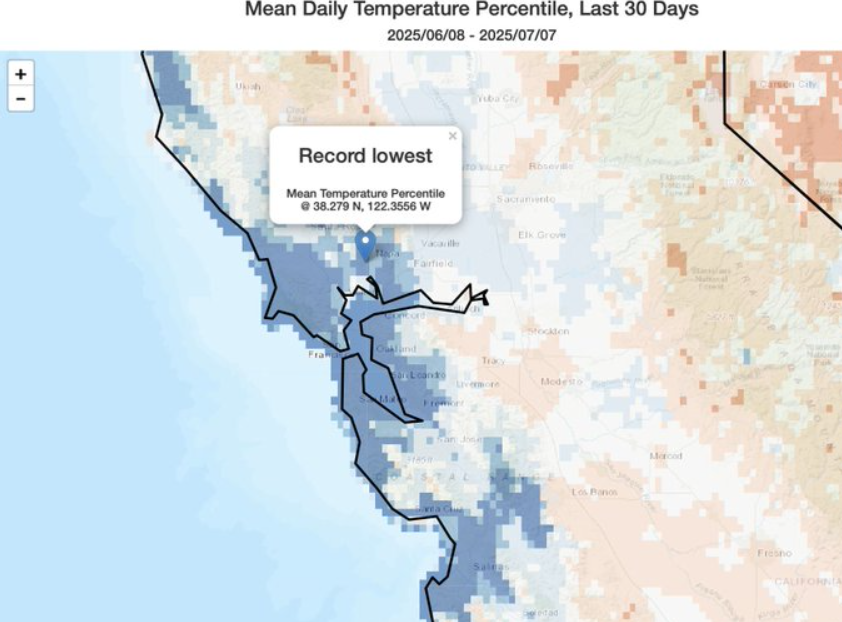
While much of the world battles scorching heatwaves, millions of Californians in the Bay Area and Northern California have likely just lived through their coldest early summer on record /similarly like Italy: https://mkweather.com/tunisia-nefza-35-4c-the-hottest-night-ever-palermo-colder-than-march-records-so-far-italys-national-year-to-date-maximum-is-the-lowest-ever-recorded-in-modern-history//. Over the past 30 days, a large portion of the region — especially areas around the San Francisco Bay — has experienced persistent record-low temperatures, turning summer expectations upside down.
According to meteorological analyses, the region (shaded in dark blue on anomaly maps) has recorded daily highs and lows far below seasonal norms, with some cities enduring historically low daytime temperatures for June and early July. San Francisco, typically known for its mild summers, has been particularly affected. Since June 1, the city has registered just one day where the temperature reached 70°F (21°C) — an astonishing figure for a city that averages several such days each summer month.
This deep marine layer, reinforced by a stubborn trough pattern over the Pacific Northwest and persistent onshore winds, has trapped cold air over coastal and inland valleys alike. The usual fog and overcast skies that define the Bay Area’s “June Gloom” have extended unusually deep into July, keeping daytime highs in the 50s and 60s °F (10–18°C) for weeks on end.
The chill has been especially pronounced across the North Coast, the San Francisco Peninsula, and even parts of the Central Valley, where cities like Santa Rosa, Sacramento, and Redding have struggled to warm up to typical early summer levels.
While colder-than-average weather may be a welcome reprieve for some, prolonged cool spells in early summer can disrupt agriculture, delay seasonal tourism, and even affect natural gas usage, as homes rely more on heating than usual. Vineyards, produce farms, and stone fruit orchards in Northern California — particularly sensitive to temperature swings — may see slight shifts in growth cycles and harvest timelines.
This event stands in sharp contrast to record-breaking warmth across the Eastern U.S., Europe, and Asia, highlighting the regional complexity of climate variability. While the globe continues to warm on average, localized cold anomalies — like this one — can still occur and sometimes break historic records when the right atmospheric patterns align.
As of mid-July, long-range forecasts suggest a gradual warming trend may return to the Bay Area later this month. But for now, 2025’s early summer in Northern California will go down as a memorable anomaly — colder, grayer, and more persistent than anything seen in decades.

Source: https://pbs.twimg.com/media/GvXi4NHbQAARI6U?format=jpg&name=small


























